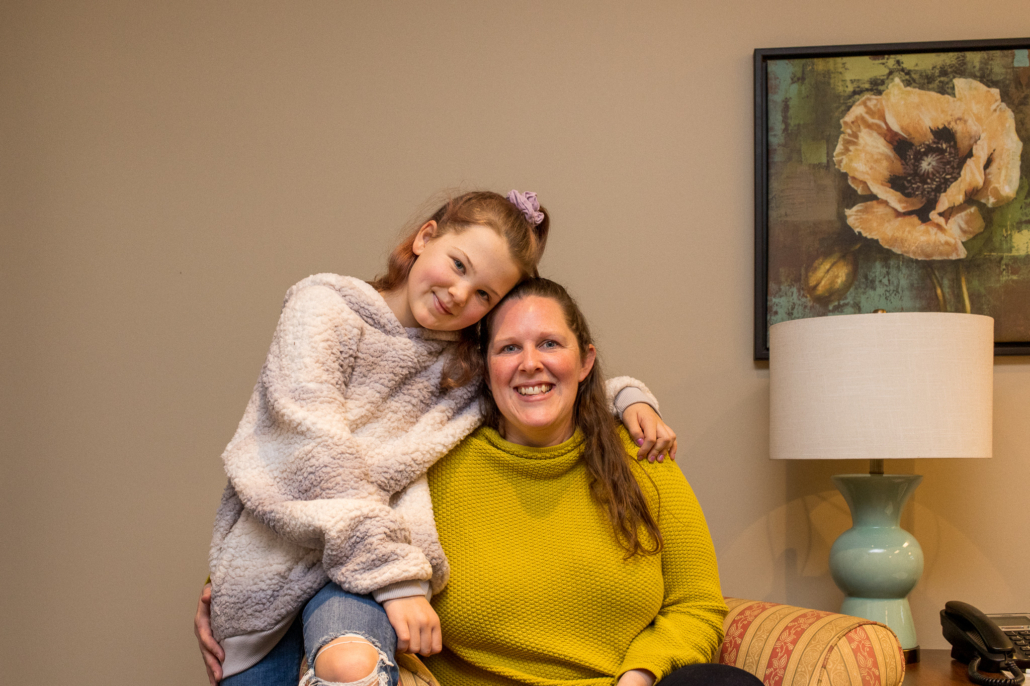Makenna, 12, lives with her mom and grandma in Sooke. Like other kids, she lives a full, meaningful life: dance classes, soccer, baseball, and gymnastics. She loves to hike, play catch, read, and go to the beach. As a preteen, Makenna’s experience in our hospitals is beyond that of many people twice her age. Or more.
For Makenna, bowel trouble began when she was only three. She would vomit at random times without being sick, have diarrhea one day and constipation the next. The school would often have to send her home.
“It felt like a sharp pain, like being stabbed,” says Makenna, recalling the stomach aches.
It would take six years to fully understand why Makenna felt this way. “Without the referrals, Dr. Allen Hayashi and his team, or the video gastroscope, we’d still be wondering what was wrong.” says Lissa, Makenna’s mom. Dr. Hayashi performs minimally invasive and endoscopic surgeries for both adults and children at Victoria General Hospital (VGH). “He not only gave us the answer to our most critical question—he gave us the solution. He’s a life-saver.”
Dr. Hayashi diagnosed Makenna with eosinophilic esophagitis. It’s tough to pronounce, so Makenna keeps it simple and just calls it “EoE.”
EoE is a chronic immune disease that can appear in children or adults. Often, certain foods will trigger an allergic reaction. This causes a type of white blood cell to build up in the esophagus, the tube that connects the mouth and stomach. These cells are meant to stay in the digestive tract. In the esophagus, they inflame or injure the tissue.
To diagnose EoE, Dr. Hayashi performed an endoscopy on Makenna. He used a tool called a video gastroscope to examine her esophagus, stomach, small intestine, and colon. The scope, a camera on the end of a small, thin flexible tube, was inserted through her mouth, without the need for any incisions. Makenna was put under for the procedure.
Even when the esophagus looks normal through the scope, a patient may have EoE. So a small tissue sample is taken, known as a biopsy. If the white blood cells are found in the sample, this can help diagnose EoE.
Right now, an endoscopy with a biopsy is the only way to diagnose EoE. The video gastroscope is crucial for performing such a procedure at VGH.
Makenna and Lissa are sharing their story in support of the Victoria Hospitals Foundation’s Big Picture campaign. They hope to inspire philanthropy in our community. Through the campaign, you can help fund new imaging tools like the video gastroscope.
Even after her EoE diagnosis, Dr. Hayashi and his fellow caregivers still needed to know what was triggering her allergic reactions. Makenna tried an elimination diet and returned for a second and third endoscopy and biopsy to determine which food was the allergen.
“The care team was so supportive, so compassionate. They sensed when we felt stressed or nervous,” her mom says. “We’re so grateful for the equipment Makenna benefited from, and for care we’ve received along the way.”
When her results came back clear, Dr. Hayashi confirmed that Makenna’s EoE was triggered by a severe dairy allergy.
In supporting The Big Picture campaign, donors like you can help patients like Makenna get answers.
EoE can be isolating at 12 years old. “It’s torturous to go into a bakery,” says Makenna. “Birthday parties are bad. When you go into the grocery store, walking past cheese bread or cakes sucks.”
EoE is a lifelong condition. Something that Makenna—at only 12—is remarkably mature in understanding.
“If it wasn’t for the scope, my throat would probably be closed up by now,” says Makenna. “And we still wouldn’t know what was going on.”
“It was so important to catch this disease early,” says Lissa. “If left untreated, ridges can form in the esophagus that make it impossible to swallow. So someone might need a feeding tube because they can’t swallow food. Thanks to Dr. Hayashi, we never got to that point. Without the video gastroscope, we’d still be playing a guessing game.”
Funding a new video gastroscope is part of The Big Picture. Can you help?
At the moment, the pediatric surgery team shares their video gastroscope with adult surgery. “Sometimes we want to use the equipment and we can’t,” admits Dr. Hayashi. “When it’s in use, in need of repair, or being cleaned, a child will need to wait.” A new, more advanced gastroscope alleviates that problem.
“With its higher-quality images, the new gastroscope allows us to examine areas of concern in real time. This improves diagnosis and treatment of a range of conditions,” says Dr. Hayashi. “The new video gastroscope has far better resolution and accuracy. It’s revolutionary.”
“I’m so grateful for everyone who helped us along the way,” says Lissa. “To those who might donate to this campaign, thank you. You are placing necessary tools in our care teams’ hands.”
For patients like Makenna, you can bring the big picture of their care into focus. To learn more about The Big Picture campaign, or to donate, visit victoriahf.ca/bigpicture/.





